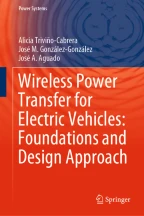Fundamentals of Wireless Power Transfer

Wireless power transfer comprises a set of heterogeneous technologies. Their correct applicability depends on the power requirements and the scenario in which it is expected to be used (position between transmitter and receiver, separation between them, electronics dimensions, etc.). First, this chapter describes how wireless power transfer systems have evolved. Then, the main operating principles of the wireless power techniques are explained.
This is a preview of subscription content, log in via an institution to check access.
Access this chapter
Subscribe and save
Springer+ Basic
€32.70 /Month
- Get 10 units per month
- Download Article/Chapter or eBook
- 1 Unit = 1 Article or 1 Chapter
- Cancel anytime
Buy Now
Price includes VAT (France)
eBook EUR 96.29 Price includes VAT (France)
Softcover Book EUR 126.59 Price includes VAT (France)
Hardcover Book EUR 126.59 Price includes VAT (France)
Tax calculation will be finalised at checkout
Purchases are for personal use only
References
- Energous WattUp® Wire-Free Charging Technology. http://energous.com/
- Energy Research | Navigant Research. https://www.navigantresearch.com/
- IHS Markit | Leading Source of Critical Information. https://ihsmarkit.com/index.html
- Ossia: Proven Wireless Power Technology You Can Use Today. http://www.ossia.com/
- Technology - Long Range Wireless Power Transmission | Wi-Charge.com. https://www.wi-charge.com/technology/
- Wireless Power Products - Powercastco.com. https://www.powercastco.com/
- Chow, J.P.W., Chung, H.S.H., Cheng, C.S.: Online regulation of receiver-side power and estimation of mutual inductance in wireless inductive link based on transmitter-side electrical information. In: 2016 IEEE Applied Power Electronics Conference and Exposition (APEC), pp. 1795–1801. IEEE (2016). https://doi.org/10.1109/APEC.2016.7468111.http://ieeexplore.ieee.org/document/7468111/
- Dai, J., Ludois, D.C.: A survey of wireless power transfer and a critical comparison of inductive and capacitive coupling for small gap applications. IEEE Trans. Power Electron. 30(11), 6017–6029 (2015). https://doi.org/10.1109/TPEL.2015.2415253, http://ieeexplore.ieee.org/document/7064773/ArticleGoogle Scholar
- Gibbs, Y.: NASA Dryden Fact Sheets - Beamed Laser Power (2015). https://www.nasa.gov/centers/armstrong/news/FactSheets/FS-087-DFRC.html
- Jeong, S.Y., Thai, V.X., Park, J.H., Rim, C.T.: Self-inductance-based metal object detection with mistuned resonant circuits and nullifying induced voltage for wireless EV chargers. IEEE Trans. Power Electron. 34(1), 748–758 (2019). https://doi.org/10.1109/TPEL.2018.2813437, https://ieeexplore.ieee.org/document/8309279/ArticleGoogle Scholar
- Jin, K., Zhou, W.: Wireless laser power transmission: a review of recent progress. IEEE Trans. Power Electron. 34(4), 3842–3859 (2019). https://doi.org/10.1109/TPEL.2018.2853156. https://ieeexplore.ieee.org/document/8404085/ArticleGoogle Scholar
- Kalwar, K.A., Aamir, M., Mekhilef, S.: Inductively coupled power transfer (ICPT) for electric vehicle charging A review. Renew. Sustain. Energy Rev. 47, 462–475 (2015). https://doi.org/10.1016/J.RSER.2015.03.040, https://www.sciencedirect.com/science/article/pii/S1364032115001938ArticleGoogle Scholar
- Kim, H.J., Hirayama, H., Kim, S., Han, K.J., Zhang, R., Choi, J.W.: Review of near-field wireless power and communication for biomedical applications. IEEE Access 5, 21,264–21,285 (2017). https://doi.org/10.1109/ACCESS.2017.2757267, http://ieeexplore.ieee.org/document/8052089/ArticleGoogle Scholar
- Kisseleff, S., Chen, X., Akyildiz, I.F., Gerstacker, W.H.: Efficient charging of access limited wireless underground sensor networks. IEEE Trans. Commun. 64(5), 2130–2142 (2016). https://doi.org/10.1109/TCOMM.2016.2550435, http://ieeexplore.ieee.org/document/7447753/ArticleGoogle Scholar
- Lu, K., Nguang, S.K., Ji, S., Wei, L.: Design of auto frequency tuning capacitive power transfer system based on class-E2 dc/dc converter. IET Power Electron. 10(12), 1588–1595 (2017). https://doi.org/10.1049/iet-pel.2016.0655, http://digital-library.theiet.org/content/journals/10.1049/iet-pel.2016.0655ArticleGoogle Scholar
- Massa, A., Oliveri, G., Viani, F., Rocca, P.: Array designs for long-distance wireless power transmission: state-of-the-art and innovative solutions. Proc. IEEE 101(6), 1464–1481 (2013). https://doi.org/10.1109/JPROC.2013.2245491, http://ieeexplore.ieee.org/document/6472725/ArticleGoogle Scholar
- Mirbozorgi, S.A., Bahrami, H., Sawan, M., Gosselin, B.: A smart multicoil inductively coupled array for wireless power transmission. IEEE Trans. Ind. Electron. 61(11), 6061–6070 (2014). https://doi.org/10.1109/TIE.2014.2308138, http://ieeexplore.ieee.org/document/6748029/ArticleGoogle Scholar
- Pavo, J., Badics, Z., Bilicz, S., Gyimothy, S.: Efficient perturbation method for computing two-port parameter changes due to foreign objects for WPT systems. IEEE Trans. Magn. 54(3), 1–4 (2018). https://doi.org/10.1109/TMAG.2017.2771511, http://ieeexplore.ieee.org/document/8122030/ArticleGoogle Scholar
- Popovic, Z.: Cut the cord: low-power far-field wireless powering. IEEE Microw. Mag. 14(2), 55–62 (2013). https://doi.org/10.1109/MMM.2012.2234638, http://ieeexplore.ieee.org/document/6475366/ArticleGoogle Scholar
- Sasaki, S., Tanaka, K.: Wireless power transmission technologies for solar power satellite. In: 2011 IEEE MTT-S International Microwave Workshop Series on Innovative Wireless Power Transmission: Technologies, Systems, and Applications, pp. 3–6. IEEE (2011). https://doi.org/10.1109/IMWS.2011.5877137, http://ieeexplore.ieee.org/document/5877137/
- Thrimawithana, D.J., Madawala, U.K.: A primary side controller for inductive power transfer systems. In: 2010 IEEE International Conference on Industrial Technology, pp. 661–666. IEEE (2010). https://doi.org/10.1109/ICIT.2010.5472724, http://ieeexplore.ieee.org/document/5472724/
- Triviño-Cabrera, A., Aguado-Sánchez, J.: A review on the fundamentals and practical implementation details of strongly coupled magnetic resonant technology for wireless power transfer. Energies 11(10), 2844 (2018). https://doi.org/10.3390/en11102844, http://www.mdpi.com/1996-1073/11/10/2844ArticleGoogle Scholar
- Triviño-Cabrera, A., Lin, Z., Aguado, J.: Impact of coil misalignment in data transmission over the inductive link of an EV wireless charger. Energies 11(3), 538 (2018). https://doi.org/10.3390/en11030538, http://www.mdpi.com/1996-1073/11/3/538ArticleGoogle Scholar
- Trivino-Cabrera, A., Ochoa, M., Fernandez, D., Aguado, J.A.: Independent primary-side controller applied to wireless chargers for electric vehicles. In: 2014 IEEE International Electric Vehicle Conference (IEVC), pp. 1–5. IEEE (2014). https://doi.org/10.1109/IEVC.2014.7056193, http://ieeexplore.ieee.org/document/7056193/
- Yan, Z., Zhang, Y., Kan, T., Lu, F., Zhang, K., Song, B., Mi, C.C.: Frequency optimization of a loosely coupled underwater wireless power transfer system considering eddy current loss. IEEE Trans. Ind. Electron. 66(5), 3468–3476 (2019). https://doi.org/10.1109/TIE.2018.2851947, https://ieeexplore.ieee.org/document/8408696/ArticleGoogle Scholar
- Zhang, Z., Chau, K.T., Qiu, C., Liu, C.: Energy encryption for wireless power transfer. IEEE Trans. Power Electron. 30(9), 5237–5246 (2015). https://doi.org/10.1109/TPEL.2014.2363686, http://ieeexplore.ieee.org/document/6928497/ArticleGoogle Scholar
- Zhou, W., Jin, K.: Efficiency evaluation of laser diode in different driving modes for wireless power transmission. IEEE Trans. Power Electron. 30(11), 6237–6244 (2015). https://doi.org/10.1109/TPEL.2015.2411279, http://ieeexplore.ieee.org/document/7056428/ArticleGoogle Scholar
Author information
Authors and Affiliations
- Escuela de Ingenierías Industriales, University of Malaga, Málaga, Spain Alicia Triviño-Cabrera, José M. González-González & José A. Aguado
- Alicia Triviño-Cabrera

